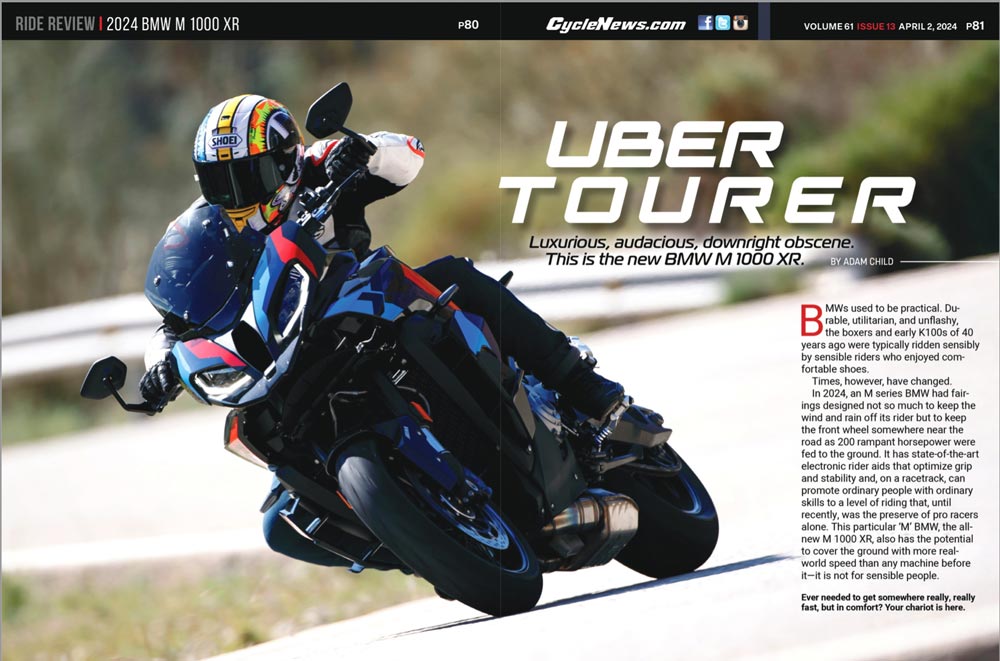| April 5, 2024
BMWs used to be practical. Durable, utilitarian, and unflashy, the boxers and early K100s of 40 years ago were typically ridden sensibly by sensible riders who enjoyed comfortable shoes.
Times, however, have changed.
 Ever needed to get somewhere really, really fast, but in comfort? Your chariot is here.
Ever needed to get somewhere really, really fast, but in comfort? Your chariot is here.
By Adam Child | Photos by BMW Motorrad
In 2024, an M series BMW had fairings designed not so much to keep the wind and rain off its rider but to keep the front wheel somewhere near the road as 200 rampant horsepower were fed to the ground. It has state-of-the-art electronic rider aids that optimize grip and stability and, on a racetrack, can promote ordinary people with ordinary skills to a level of riding that, until recently, was the preserve of pro racers alone. This particular ‘M’ BMW, the all-new M 1000 XR, also has the potential to cover the ground with more real-world speed than any machine before it—it is not for sensible people.
The M 1000 XR is the third model from the German manufacturer to take the high-performance M treatment. And if the M 1000 R and M 1000 RR that came before it are lighter, faster, brain-twisting versions of the S 1000 R sports-naked and S 1000 RR superbike, the M 1000 XR, which adds over 30 horsepower, an aero package, acres of carbon fiber and the most sophisticated rider aids available on a production machine to the S 1000 XR crossover, looks set to redefine the meaning of sports touring.
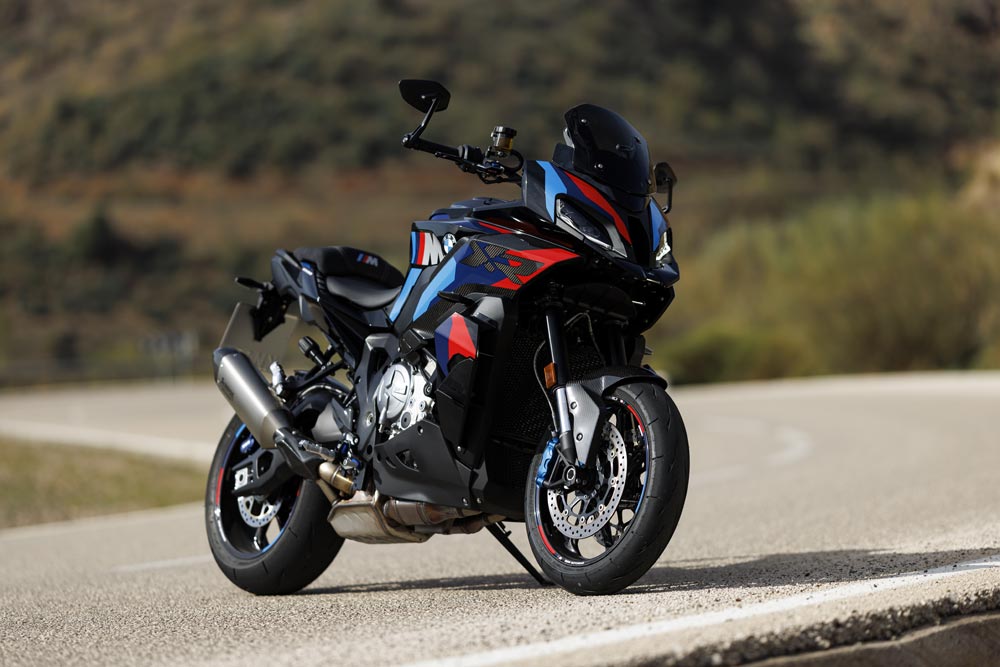 It’s incredible to think this bike, a sport tourer, has more performance than a WorldSBK racer did 15 years ago. What an age we live in.
It’s incredible to think this bike, a sport tourer, has more performance than a WorldSBK racer did 15 years ago. What an age we live in.
I can’t recall any of our CN readers complaining that the base S 1000 XR was underpowered or lacking in excitement, but the M nevertheless arrives in showrooms with a 201 horsepower peak power output and downforce-generating wings. Like Ducati, which recently developed the utterly unhinged Multistrada V4 RS, BMW has clearly concluded that in 2024, a distance machine can be, and should have, anything—that breathtaking engine performance and WorldSBK aerodynamics can sit alongside all-day comfort once found only on luxury distance machines.
Starting with its powerplant, the M XR gets a modified version of the S 1000 R’s ShiftCam 999cc inline-four, producing 201 horsepower at 12,750 rpm. Peak torque is 83.3 lb-ft at 11,000 rpm, with the redline at a foolish 14,600 rpm. The final gearing and top three cogs in the gearbox are slightly shorter than the S 1000 XR’s, and there is Pro Shift Assist for slicker changes and an anti-hopping slipper clutch.
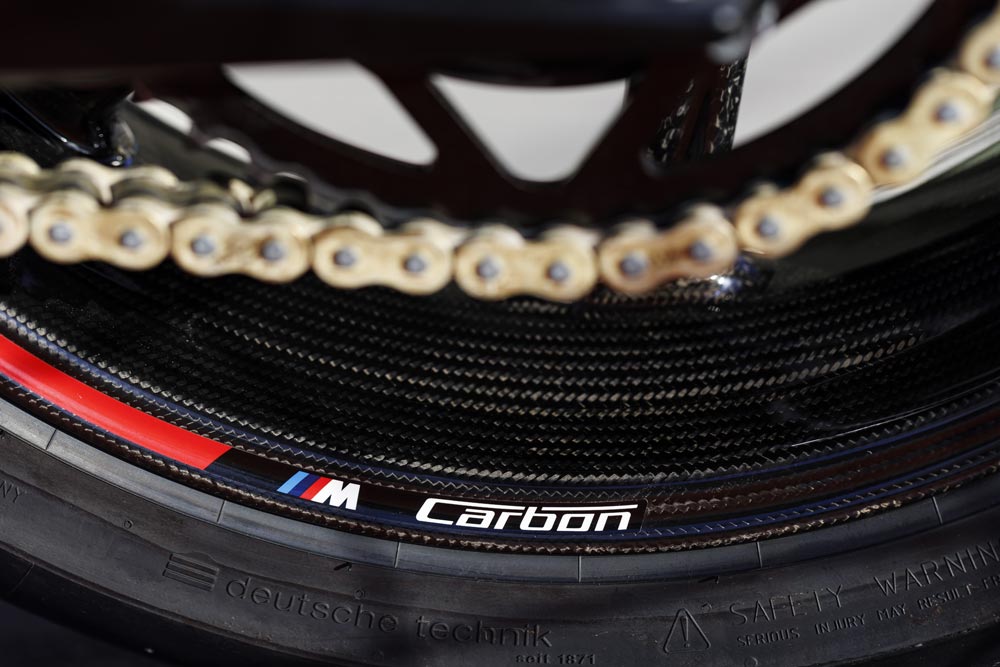 We defy you to show us something sexier on a motorcycle than carbon-fiber wheels. Especially ones with the BMW M sticker on them.
We defy you to show us something sexier on a motorcycle than carbon-fiber wheels. Especially ones with the BMW M sticker on them.
BMW says that the M 1000 XR is more powerful across the whole rev range than the S 1000 XR and 1.3 seconds faster from 0 to 125 mph—and truthfully, I was a little intimidated as I approached it for my first ride. There’s a huge amount of angular carbon plus those protruding wings. And being a crossover, it’s tall—and I’m not.
However, within a few miles of leaving BMW’s test base in southern Spain it was apparent that this special M is more than a WorldSBK racer on stilts. The ShiftCam means it isn’t peaky and, at low speeds, it’s easygoing and docile—in fact, around town, the odd burble from the Akrapovic exhaust is the only indication you’re riding something special.
As the pace and revs pick up, the M 1000 XR drives hard but without drama through a strong mid-range. The engine is smooth; there’s an air of nonchalant sophistication as you nudge the quickshifter up and down, enjoying the torque and a brisk, satisfying ride.
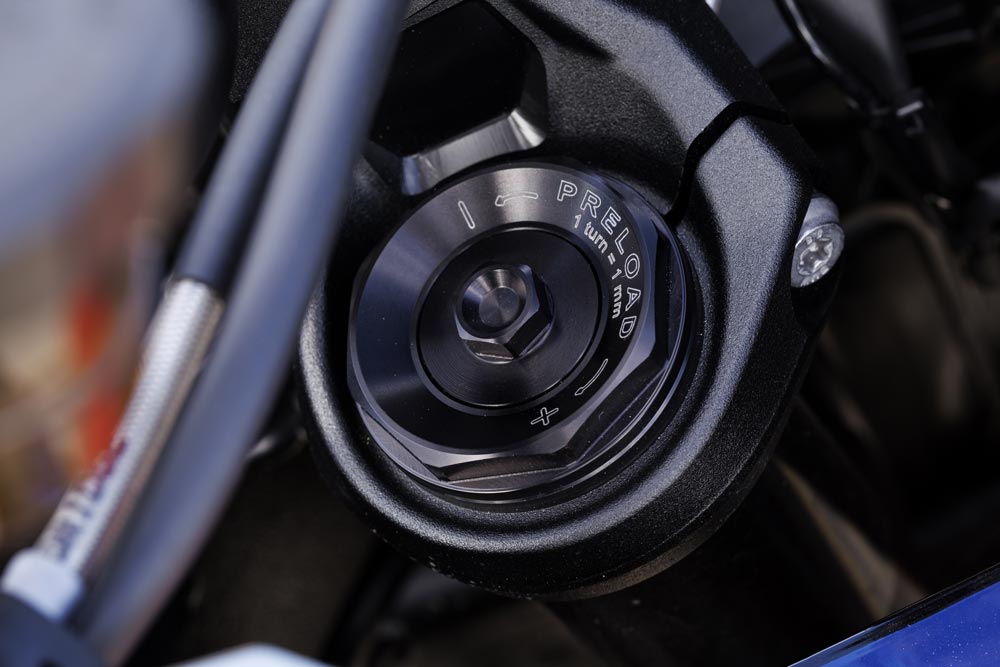 Yes, the suspension is electronic, but preload changes are still done in the old-fashioned way.
Yes, the suspension is electronic, but preload changes are still done in the old-fashioned way.
Sitting tall and supremely comfortable in a deep plush seat, arms gently stretched to accommodatingly wide bars. Everything is much as it would be on the base S 1000 XR. Then you open the throttle, release as many of those 200 horses as you dare, and all that changes. The acceleration, initially at least, feels shockingly violent and, on the freeway, our test bike stampeded to 160 mph before I could even think about it (closed road obviously, officer).
I had to recalibrate and adjust to the M’s natural pace. The acceleration is ruthless, but the bike itself remains unmoved by the drama it’s creating, and there’s a strange disconnect between its pace and its riding position. On a pure sports bike, you are hunched over and probably wearing race leathers, so 150 mph feels fast. On the M 1000 XR, however, you just sit there, twist the throttle, and potentially go straight to prison. Truly, speeding has never been so easy. However, don’t use this as a legal defense.
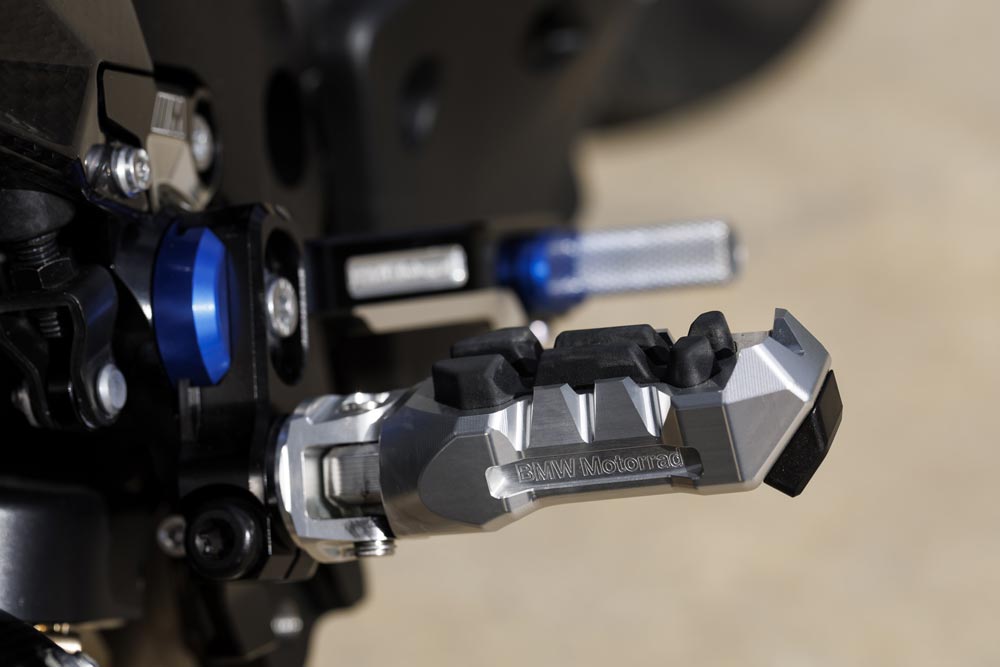 Billet footpegs on our test bike add a touch of class.
Billet footpegs on our test bike add a touch of class.
Most roads and even racetracks are too small for this machine. Its natural habitats are the unrestricted Mountain section of the Isle of Man or the Nürburgring in Germany. On less-than-perfect road surfaces in Spain, with the rider aids working overtime to control a cold Bridgestone RS11 rear tire, I only once summoned the bravery to remove the traction control (which can be done on the move), sit back, and unleash everything it has. When I did, the acceleration was so immense my brain seized like a cheap two-stroke, and that was without revving close to that 14,600 rpm redline. Mainly, I was playing with it. Tickling it.
All this raucous performance is managed and supported by a 6-axis IMU and easily interchangeable riding modes, plus quadruple-wing M winglets, which, at 136 mph, produce 25.13 pounds of downforce. The suspension is, of course, fully adjustable and also electronically set by Dynamic Damping Control with base settings linked to each riding mode, and the steering damper is adjustable, too. When you are in Road, Race, or Dynamic modes, the suspension self-adjusts to your riding and the conditions on the move. However, in any one of the Race Pro modes you can fine-tune the suspension, adjusting compression and rebound damping electronically, which then becomes fixed and doesn’t change on the move. The theory is that once you’ve set the suspension, you have a base setup for the track, which can then be tweaked once you get back to the pits and do so via a few presses of a button rather than having to use grubby tools.
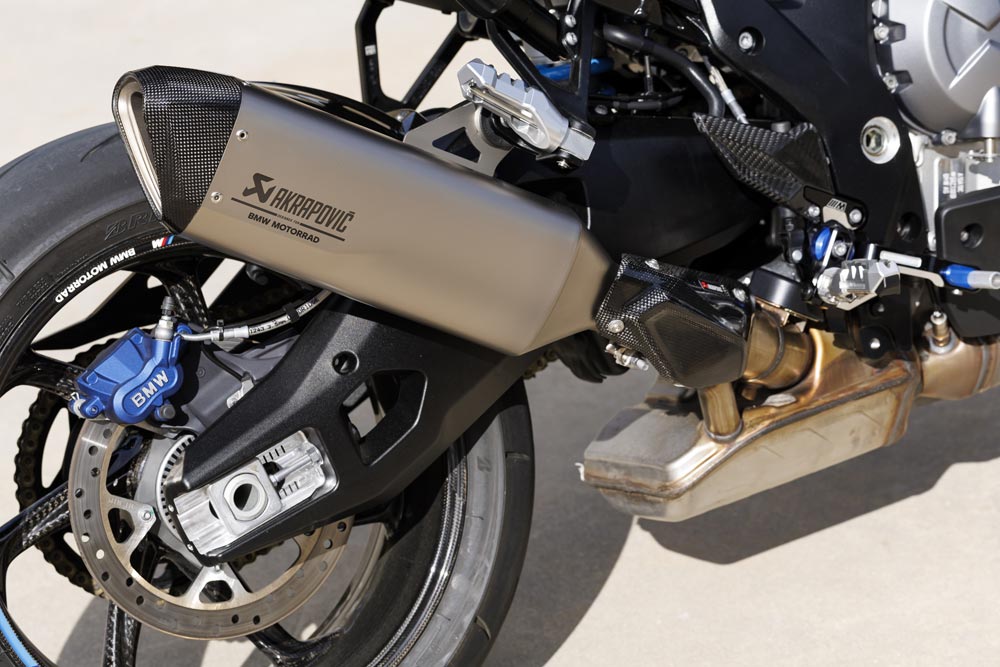 The Akrapovic exhaust looks and sounds like a gem. Unfortunately, you’re stuck with the big cat converter under the motor unless you want to make your M an illegal one. Probably not worth the hassle.
The Akrapovic exhaust looks and sounds like a gem. Unfortunately, you’re stuck with the big cat converter under the motor unless you want to make your M an illegal one. Probably not worth the hassle.
The rider, meanwhile, sits tall on a 33.46-inch-high seat and suspension with 5.43 inches of travel. The bars are flat and wide; there’s a superb 6.5-inch TFT color display, cruise control, and heated grips switched on. In other words, you are set up nicely to tour sportily.
At 491 pounds, or 485 pounds on our M Competition test bike, the M 1000 XR is hardly lithe or minimalist. In fact, its girth and height give the impression of a heavy machine, but on the road, it doesn’t feel it. Some of the surfaces we encountered in southern Spain would be more suitable for supermoto than a 200 horsepower sports tourer, but the M absolutely nailed their tight switchback sections.
The steering is light, the ride is plush, and the suspension control is complete. Push it a little, and the M 100 XR reveals responsive sportbike handling that makes it capable of embarrassing full-on sportbikes, especially on imperfect roads.
That 6.6-pound weight saving is due to the carbon wheels—the base M gets forged rims—which also reduce rotating and unsprung mass and help it steer and change direction with stunning speed and accuracy. Stopping power is impressive, while the ABS system is lean-sensitive and changeable. Engine-brake strategies can also be tailored to match the ride, but we really need a track test to explore the potential of both.
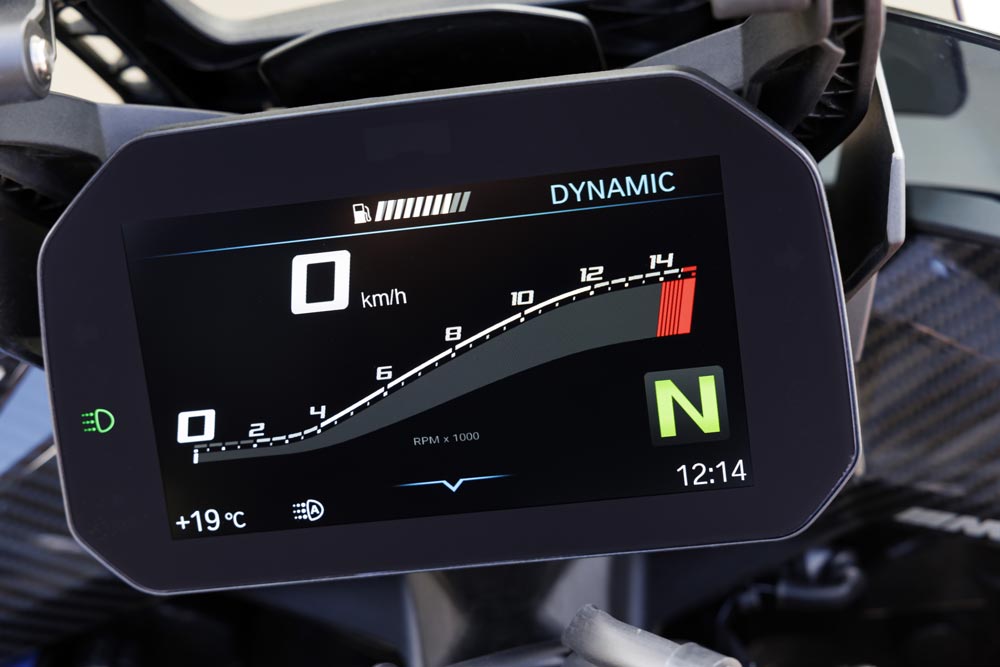 The same 6.5-inch dash as found on many of BMW’s top-of-the-line models adorns the M XR.
The same 6.5-inch dash as found on many of BMW’s top-of-the-line models adorns the M XR.
Comfort over a day in the saddle is good. The riding position feels natural with relaxed, wide bars. There’s a supportive seat, cruise control, heated grips, an adjustable screen, and the plush ride quality of semi-active suspension. In fact, I can’t think of many bikes that combine such blistering performance with such a high level of comfort, and this combination is the M’s ace card.
Unfortunately, we only got a taste of the M’s touring potential (it should be noted that the M is not equipped to carry panniers or a top box). We need to re-visit the bike to test its high-speed fuel consumption, tank range, and vibrations, but initial impressions are favorable indeed.
As with all new BMWs, there are countless options and accessories to choose from. BMW’s online configurator is the place to look for official accessories, including the M Competition package, which is similar to those found on the M 1000 R and M 1000 RR and includes the M GPS-Laptrigger and carbon and billet parts, plus those carbon wheels and Blackstorm paintwork.
The level of finish, packaging and detailing is supremely high, while the rider aids are accessible and give an endless list of options. This XR can be tailored for fast laps at Laguna Seca or a run to the mall. And while the pitlane limiter may be designed for trackdays, I can see it being deployed on the road, too, especially for those dreaded average speed cameras.
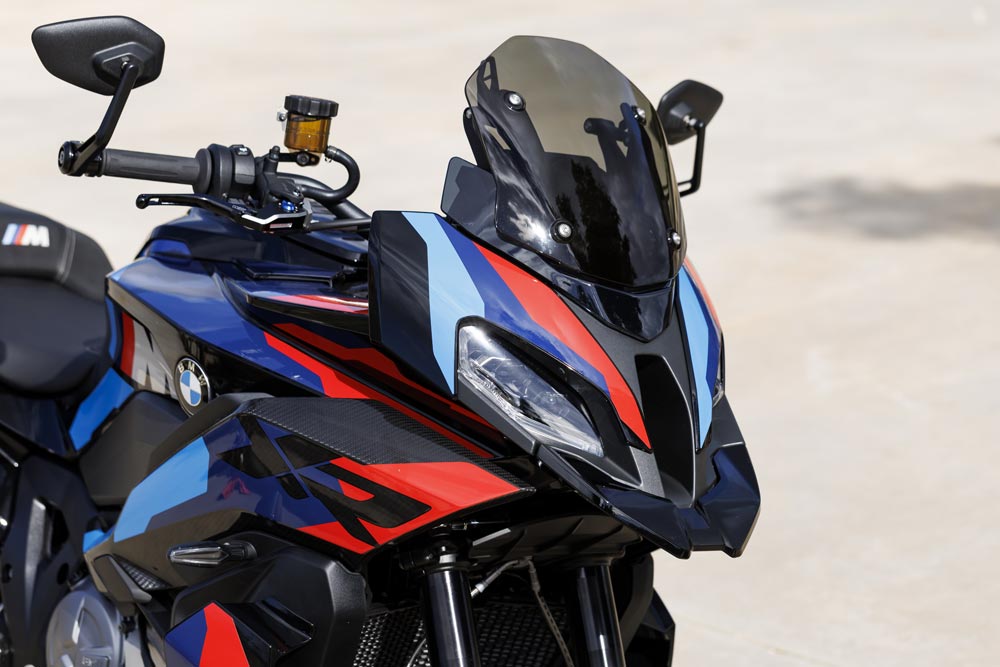 BMW’s colorways just seem to be getting better and better each year. The M is definitely a looker.
BMW’s colorways just seem to be getting better and better each year. The M is definitely a looker.
Overall, I don’t think there is any other bike on the market that so perfectly matches speed, power, handling and comfort and the practicality of a bike that can be ridden every day. On the German Autobahn, the M will eat up miles at a rate not many bikes, if any, will be able to match.
Kawasaki has the supercharged SX, but it can’t get close to the M in the corners and isn’t as versatile. Ducati has the exotic Multistrada V4 RS, which I have ridden and might run the BMW close on a tight track. But the Beemer has even more power and less weight. If there were no speed limits between Paris and Rome, this Beemer would reach the Eternal City first.
Those of a certain age may recall how the landmark sports-tourers such as the Suzuki Hayabusa and Kawasaki ZZ-R 1400 had dual personalities: the smoothness and serenity of the TGV train gliding across France at 85 mph, and the devastating ability to double that figure in seconds and transform your perception of what fast truly means. Well, the news is that the M 1000 XR is the new landmark machine.CN
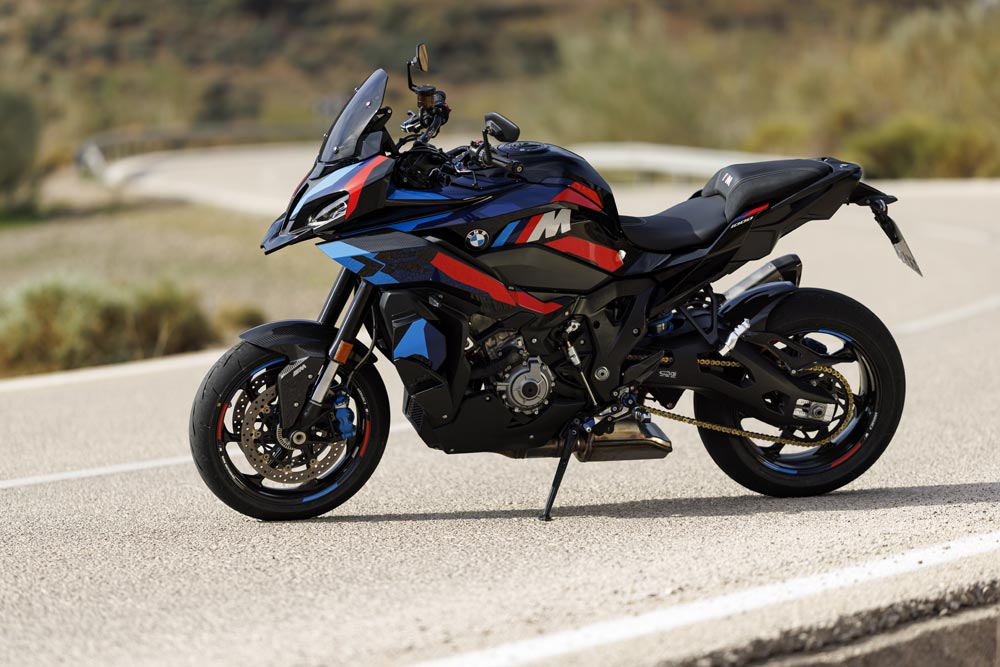
2024 BMW M 1000 XR Specifications
| MSRP: |
$29,995 |
| Engine: |
inline four-cylinder |
| Displacement: |
999cc |
| Bore x Stroke: |
80 x 49.7mm |
| Drivetrain: |
4-valves per cylinder |
| Cooling system: |
Liquid |
| Power (claimed): |
198.3 bhp/201 hp at 12,750 rpm |
| Torque (claimed): |
83.3 lb-ft at 11,100 rpm |
| Transmission: |
Six-speed, chain final drive |
| Electronics: |
Riding modes Pro (Rain, Road, Dynamic, Race, Race Pro 1–3, Pit-Lane Limiter, Launch Control, Dynamic Traction Control (DTC) +/- Shift, Wheelie Control, Slide Control, Dynamic Brake Control (DBC), Shift Assistant Pro, Automatic Hill Start Control (HSC) Pro), Dynamic Damping Control (DDC), BMW Motorrad ABS Pro, Adjustable Steering Damper, Keyless Ride, Tire-Pressure Control (TPC), Heated Grips, Cruise Control, USB Charging Interface |
| Chassis: |
Bridge-type frame, cast aluminum, engine as stressed member |
| Front suspension: |
45mm inverted fork. Electronic self-adjusting rebound/compression damping (Dynamic ESA) |
| Front-wheel travel: |
5.4 in. |
| Rear suspension: |
Aluminum double-sided swingarm, central shock absorber. Electronic preload adjuster, electronic self-adjusting rebound/compression damping (Dynamic ESA) |
| Rear-wheel travel: |
5.4 inch |
| Front brake: |
4-piston monobloc calipers, dual 320mm rotors |
| Rear brake: |
Single piston caliper, 220mm rotor |
| Front wheel: |
120/70 ZR17 in. |
| Rear wheel: |
200/55 ZR17 in. |
| Wheelbase: |
60.9 in. |
| Seat height: |
33.4 in. |
| Head angle: |
64.9° |
| Trail: |
4.62 in. |
| Fuel capacity: |
5.3 gal. |
| Weight (wet, claimed): |
492 lb |
